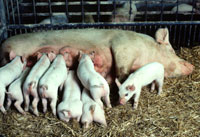Last January, inspectors with the U.S. Food and Drug Administration paid a visit to the University of Illinois, where researchers have been studying the DNA of pigs. The pig project, based in Champaign-Urbana, is one of dozens of experiments being conducted across the country in which scientists are altering the genetic structure of animals in hopes of making them fatter, healthier, and more profitable.
Pigging out.
Photo: USDA.
In the University of Illinois project, cow genes were inserted into sows to increase their milk production, and a synthetic gene was added to make milk digestion easier for the piglets, thereby causing them to grow faster. But instead of the experimental swine being destroyed, as required by the FDA, 386 piglets were sold to livestock brokers, who then sold them to slaughterhouses, who sold them to grocery stores, who sold them to consumers as pork chops, sausage, and bacon.
University officials claim the piglets did not inherit the genetic baggage of their moms, and the government does not believe the incident presented a public-health risk. But the slipup is emblematic of a federal r... Read more

